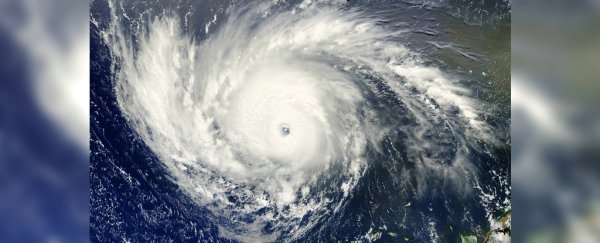Hurricanes are one thing. Earthquakes are another. But these hazardous events aren't mutually exclusive, and sometimes one can even feed the other.
In a new study, scientists have identified what they say is a new geophysical phenomenon entirely unknown to science – a hybrid entity where powerful storms such as hurricanes trigger seismic episodes that can rumble for hours or even days.
"We're calling them 'stormquakes'," says geophysicist Wenyuan Fan from Florida State University.
"During a storm season, hurricanes or nor'easters transfer energy into the ocean as strong ocean waves, and the waves interact with the solid earth producing intense seismic source activity."
It sounds reasonable, coming from a seismologist. Yet the strange thing is that nobody has ever discovered this link before, though not for lack of evidence.
When Fan and his team combed through over 12 years of seismic and oceanographic data recorded from 2006 to 2019, they uncovered more than 14,000 stormquakes being spawned in waters offshore both the US coasts, plus Canada, and the Gulf of Mexico.
While it will take additional investigations to know for sure, the team also thinks the phenomenon could be occurring in Western Europe and Western Australia, but like in North America, it simply hasn't been recognised before now.
What helped the team identify stormquakes this time was by focusing on fuzzy seismic signals produced by interactions between the ocean and solid earth – data generally regarded (and disregarded) as background or ambient noise.
These noisy wave-fields are considered "typically incoherent" the researchers explain in their new paper, using the terminology of a traditional seismological perspective.
"We just didn't know where to look and what to look for," Fan explained to National Geographic.
Fresh insights struck, though, when the team zeroed in on low-frequency earthquake waves, and realised there was indeed a coherent link in the noise when strong storms at sea generated long-period ocean waves in waters with shallow seafloor features near the edge of continental shelves.
If those conditions are satisfied, stormquakes can result, and may "migrate coincident with the storms, but are effectively spatiotemporally focused seismic point sources with equivalent earthquake magnitudes that can be greater than 3.5," the authors write.
One upshot is that, fortunately enough, stormquakes shouldn't be a problem for most of us on land, because even though they seem to be incredibly common for something we never knew existed, the quake parts themselves aren't particularly powerful (even though they can be long-lasting), and there epicentres are located in the ocean.
"This is the last thing you need to worry about," Fan told Associated Press.
Just because they're not dangerous, though, doesn't mean they're not a big deal. The researchers say now that we know about stormquakes, the events will give us new source data to investigate Earth's structure in offshore locations.
"A high-resolution catalogue of stormquakes will open a new avenue to image Earth's deep interior as stormquakes occur at passive margins," the team writes, and other researchers agree the discovery could open doors.
"This paper is laying the foundation for building up new information about how the world works," earthquake geologist Wendy Bohon from the Incorporated Research Institutions for Seismology in Washington, DC, who wasn't involved with the study, told National Geographic.
"Scientists are inherently creative people. Who knows what some inspired young students are going to be able to use these for."
The findings are reported in Geophysical Research Letters.
